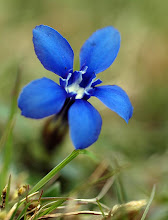Some of our project students have been working on the feeding habits of garden snails Helix aspersa and one of our postgrads, Chantelle Kerr, drew my attention to the fact that some of their snails had been laying eggs in the tanks where we were keeping them. I was hoping to see some signs of the developing embryos when I took a look at these under the microscope, but the eggs were disappointingly cloudy. But then, on closer examination, the 'cloudiness' turned out to be something rather interesting. Take a look at the eggs on the microscope slide above and you can just about see clusters of white specks inside them (double click for a larger image), especially in the two at the back.

These turned out to be vast numbers of calcium carbonate crystals, embedded in the outer gelatinous egg capsule. The purple background colour is the result of using a colour filter to improve the contrast - not the real colour of the egg interior, which is colourless.
At higher magnification you can see that some crystals are simple cubes, while others are aggregated together. What are they for? Well, a quick search of the web reveals that the embryonic snails use this store of calcium to produce their first shell - the parent snail provides them with a supply of building materials for a shell when it lays the egg. You can read more about the chemistry of snail shells by visiting the excellent Snail's Tales blog.





















